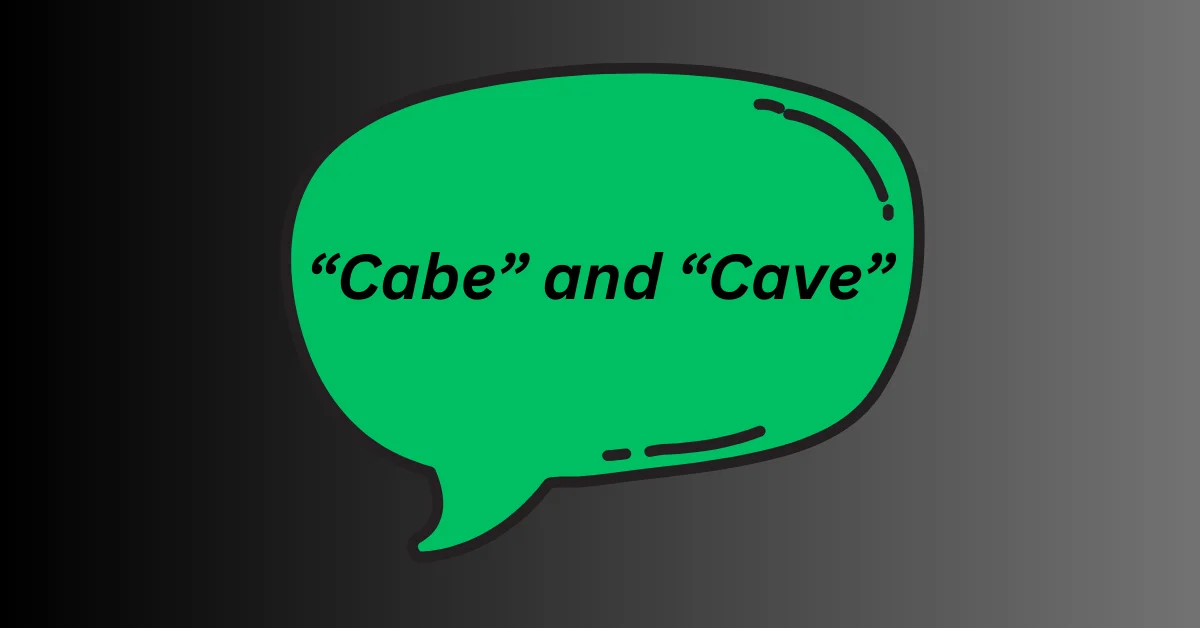When speaking in Spanish, it’s not uncommon to come across words that sound like each other but have different meanings and applications. Two of these phrases include “cabe” and “cave.” The following article will help you understand the distinction between the two, how to use them properly, and how to incorporate the words within your sentence. Be aware of common mistakes and increase your writing by using these techniques.
Introduction
Correct spelling and use of terms in Spanish are crucial for effective and clear communication. “Cabe” or “cave” can be two words that often create confusion because of their phonetic similarities. The following article will examine their meanings, grammatical usage, and instances to help you use them correctly.
Understanding “Cabe” and “Cave”
What Does “Cabe” Mean?
The word “cabe” is derived from the Spanish verb “caber,” which means to fit or to be contained within. In the first-person singular present tense, “cabe” translates to “it fits” or “it is contained.”
For example:
- “La ropa cabe en la maleta.” (The clothes fit in the suitcase.)
- “Todo cabe en la caja.” (Everything fits in the box.)
What Does “Cave” Mean?
On the other hand, “cave” comes from the verb “cavar,” which means to dig. In the third-person singular present tense, “cave” translates to “he/she/it digs” or “you dig” in a formal context.
For example:
- “El jardinero cave un hoyo.” (The gardener digs a hole.)
- “Ella cave para plantar el árbol.” (She digs to plant the tree.)
Contextual Differences
Understanding the contexts in which “cabe” and “cave” are used can significantly reduce the chances of mixing them up. Remember that “cabe” is associated with fitting or containing, while “cave” relates to digging.
Read Next: h ttps://onlypc.net/cuanto-dinero-gana-un-trader-profesional
Practical Examples
Here are some practical examples to illustrate common mistakes and their corrections:
- Incorrect: “La ropa cave en la maleta.”
- Corrected: “La ropa cabe en la maleta.”
- Incorrect: “Ella cabe para plantar el árbol.”
- Corrected: “Ella cave para plantar el árbol.”
Common Mistakes and How to Avoid Them
One common mistake is using “cabe” when “cave” is required and vice versa. This confusion often arises because both words are phonetically similar, leading to errors in writing. However, by remembering the distinct meanings of “caber” (to fit) and “cavar” (to dig), you can easily determine the correct word to use.
Tips for Correct Usage
Identify the Verb: Before choosing between “cabe” and “cave,” identify the verb you intend to use. If the action involves fitting, go with “caber” and use “cabe.” If the action involves digging, use “cavar” and choose “cave.”
Consider the Sentence Structure: Pay attention to whether the sentence requires a present tense verb or a subjunctive/imperative mood. This will help guide your choice between the two words.
Practice with Examples: The more you practice, the easier it will become to distinguish between “cabe” and “cave.” Try creating sentences using both words in different contexts to reinforce your understanding.
Background and Origins of the Word
The word “https://tanfacil.net/educacion/como-se-escribe-cabe-o-cave-2821.html” has roots in the Latin term “capere,” which means to seize or take. This origin hints at its foundational meaning related to capacity and fitting. As Spanish evolved, so did the nuances of its vocabulary. The transformation from Latin to modern Spanish introduced variations that reflected both linguistic shifts and cultural changes. In early texts, “https://tanfacil.net/educacion/como-se-escribe-cabe-o-cave-2821.html” appeared frequently in contexts involving understanding and comprehension, highlighting how language captures the human experience. Conversely, “cave,” derived from a different context altogether, points towards emptiness or hollowness—an intriguing contrast rooted deeply in historical usage.
Proper Usage Matters
Using “cabe” and “cave” correctly is important for clear communication in Spanish. Misusing these words can lead to confusion and misunderstandings, particularly in written communication. Proper usage also reflects a good command of the language, which is especially important in professional or academic settings.
The Final Verdict
The debate surrounding the correct spelling of “cabe” versus “cave” continues to intrigue linguists and language enthusiasts alike. Each variation carries its nuances, shaped by context and usage. While both words may stem from similar roots, their meanings diverge significantly based on how they are used in sentences. Through our exploration of backgrounds, interpretations, and grammatical rules, it’s clear that understanding these distinctions is crucial for fluent Spanish communication. The regional differences across Spanish-speaking countries also add layers to this linguistic puzzle.
FACTS
- “Cabe” vs. “Cave”: The article clarifies the difference between “cabe” and “cave,” which are different forms of the verb “caber” (to fit) and “cavar” (to dig), respectively.
- Usage of “Cabe”: “Cabe” is the third person singular form of the verb “caber” in the present indicative tense. It means “fits” or “is able to fit.”
- Usage of “Cave”: “Cave” is the third-person singular form of the verb “cavar” in the present subjunctive tense. It means “he/she/it digs” or “he/she/it is digging.”
- Spelling and Pronunciation: The spelling and pronunciation of “cabe” and “cave” are different because they come from different verbs and have different meanings. “Cabe” is pronounced with a soft “b” sound, while “cave” has a hard “v” sound.
- Common Confusion: The article notes that these two words are often confused due to their similar sounds but different meanings and spellings.
- Examples: The article provides examples of sentences using both “cabe” and “cave” to illustrate their correct usage in context.
FAQs
What is the difference between “cabe” and “cave”?
“Cabe” is the third person singular form of the verb “caber” (to fit) in the present indicative tense. It means “fits” or “is able to fit.” “Cave,” on the other hand, is the third-person singular form of the verb “cavar” (to dig) in the present subjunctive tense. It means “he/she/it digs” or “he/she/it is digging.”
How do you pronounce “cabe” and “cave”?
“Cabe” is pronounced with a soft “b” sound, similar to the English word “cob.” “Cave” is pronounced with a hard “v” sound, similar to the English word “cave.”
Can “cabe” and “cave” be used interchangeably?
No, “cabe” and “cave” cannot be used interchangeably as they come from different verbs and have different meanings. “Cabe” relates to fitting something, while “cave” pertains to the action of digging.
What are some examples of sentences using “cabe”?
Examples include:
“Este libro cabe en la estantería.” (This book fits on the shelf.)
“No cabe duda de que lo hará bien.” (There is no doubt that he/she will do it well.)
What are some examples of sentences using “cave”?
Examples include:
“Es importante que cave un hoyo profundo.” (It is important that he/she digs a deep hole.)
“Dudo que cave en el jardín.” (I doubt that he/she will dig in the garden.)
Conclusion
Distinguishing between “cabe” and “cave” is essential for accurate Spanish communication. “Cabe,” from the verb “caber,” means “fits” and is used to describe how something can fit into a space. In contrast, “cave,” from the verb “cavar,” refers to the action of digging. Despite their similar pronunciation, these words have distinct meanings and uses. Understanding and applying the correct term based on context will help ensure clear and effective communication
Stay Together: Truenetworth.org



